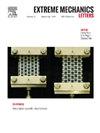Geometric dependence of curvature-induced rigidity
IF 4.5
3区 工程技术
Q2 MATERIALS SCIENCE, MULTIDISCIPLINARY
引用次数: 0
Abstract
Bending the edge of a thin elastic material promotes rigidity far from its clamped boundary. However, this curvature-induced rigidity can be overwhelmed by gravity or other external loading, resulting in elastic buckling and large deformations. We consider the role of body geometry on this competition using experiments, numerical simulations, and reduced-order models. Finite element simulations are performed using a model nonlinear hyperelastic material, and a theoretical framework is proposed that incorporates small lateral curvatures, large longitudinal rotations, and a varying cross-sectional width. A particular focus is on the comparison between rectangular and triangular sheets, and trapezoidal sheets in between. Sheet geometry affects downward tip deflection by changing the relative importance of the sheet’s weight and the rigidity provided by curvature, often in subtle ways. In extreme cases, non-monotonic deflection is observed with increasing sheet length, and a region of hysteretic bistability emerges, becoming more pronounced with rectangular sheets and large imposed curvatures. These findings demonstrate the profound impact of geometry on the competition between curvature-induced rigidity and gravity-induced deformation in thin elastic materials.
曲率诱导刚度的几何依赖性
弯曲薄型弹性材料的边缘可使其刚性远离其固定边界。然而,这种曲率引起的刚度可能被重力或其他外部载荷所淹没,导致弹性屈曲和大变形。我们使用实验、数值模拟和降阶模型来考虑身体几何在这种竞争中的作用。采用模型非线性超弹性材料进行了有限元模拟,并提出了一个包含小横向曲率,大纵向旋转和变截面宽度的理论框架。特别关注的是矩形和三角形板材之间的比较,以及两者之间的梯形板材。板的几何形状通过改变板的重量和曲率提供的刚度的相对重要性来影响向下的尖端挠度,通常以微妙的方式。在极端情况下,随着薄板长度的增加,观察到非单调偏转,并且出现了一个滞回双稳区域,在矩形薄板和大施加曲率时变得更加明显。这些发现表明几何形状对薄弹性材料中曲率诱导刚度和重力诱导变形之间的竞争有深远的影响。
本文章由计算机程序翻译,如有差异,请以英文原文为准。
求助全文
约1分钟内获得全文
求助全文
来源期刊

Extreme Mechanics Letters
Engineering-Mechanics of Materials
CiteScore
9.20
自引率
4.30%
发文量
179
审稿时长
45 days
期刊介绍:
Extreme Mechanics Letters (EML) enables rapid communication of research that highlights the role of mechanics in multi-disciplinary areas across materials science, physics, chemistry, biology, medicine and engineering. Emphasis is on the impact, depth and originality of new concepts, methods and observations at the forefront of applied sciences.
 求助内容:
求助内容: 应助结果提醒方式:
应助结果提醒方式:


